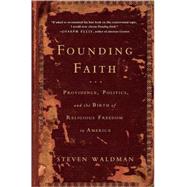
| Introduction | p. ix |
| Christian America: Settlers try to plant Protestantism as the official faith-and fail | p. 3 |
| Benjamin Franklin: The Puritan New Ager | p. 18 |
| The Evangelical Revolution: A cross-eyed preacher fuels the drive for independence and religious freedom | p. 27 |
| John Adams: The angry Unitarian | p. 33 |
| The Godly Roots of Rebellion: Fear of Anglicans and Catholics helps cause the American Revolution | p. 40 |
| George Washington: Protected by God | p. 56 |
| Holy War: George Washington uses religious tolerance, and appeals to God, to win the War of Independence | p. 64 |
| Thomas Jefferson: The pious infidel | p. 72 |
| Nature's God Meets the Supreme Judge: The Declaration of Independence and the God compromise | p. 86 |
| James Madison: The radical pluralist | p. 94 |
| "A Diabolical Persecution": A wave of bigotry in Madison's backyard changes history | p. 100 |
| The Mighty Current of Freedom: After independence, the states begin wrenching themselves from the old church-state models | p. 107 |
| Forgetting the "Powerful Friend": The Founders reject 150 years of history | p. 127 |
| The First Amendment Compromise: Building a wall that looks good from all sides | p. 141 |
| Practicing What They Preached: The first presidencies bring inspiring rhetoric, dirty politics, and sharp disagreement among the Founders | p. 159 |
| Friends in Heaven: The Founders end their spiritual journeys and prepare to continue the conversation in the next life | p. 182 |
| They Were Right | p. 188 |
| Acknowledgments | p. 207 |
| Bibliography | p. 209 |
| Notes | p. 217 |
| Index | p. 265 |
| Table of Contents provided by Ingram. All Rights Reserved. |
The New copy of this book will include any supplemental materials advertised. Please check the title of the book to determine if it should include any access cards, study guides, lab manuals, CDs, etc.
The Used, Rental and eBook copies of this book are not guaranteed to include any supplemental materials. Typically, only the book itself is included. This is true even if the title states it includes any access cards, study guides, lab manuals, CDs, etc.
Excerpted from Founding Faith: Providence, Politics, and the Birth of Religious Freedom in America by Steven Waldman
All rights reserved by the original copyright owners. Excerpts are provided for display purposes only and may not be reproduced, reprinted or distributed without the written permission of the publisher.